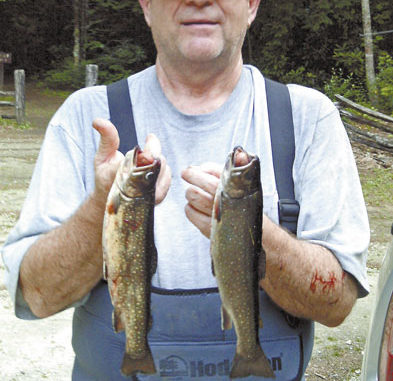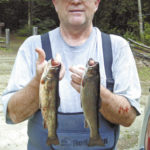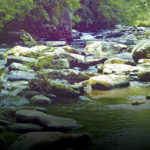
Fishing journal, June 5-8, 2011. Place: Graham County. Streams: Santeetlah Creek, Little Santeetlah Creek, Big Snowbird Creek (hatchery-supported section); Big Snowbird Creek (wild-trout waters).
From Horse Cove campground in the Nantahala National Forest near Robbinsville, you have easy access to four prime fishing waters. The closest streams are Santeetlah Creek, which runs beside a section of the campground, and Little Santeetlah Creek, part of which winds through Joyce Kilmer Memorial Forest. The big creek is hatchery-supported; the smaller creek is wild-trout waters.
A short drive away is Big Snowbird, one of the top trout streams in the Southeast. The upper section is wild-trout waters, and the lower section is hatchery-supported waters. It is one of the few streams stocked from March until August.
A colleague and I arrived at Horse Cove campground in the early afternoon on a Sunday, set up camp and headed for our first fishing destination: Little Santeetlah Creek, less than a mile from the campground. Little Santeetlah begins in the Slickrock Wilderness Area and flows through the Kilmer forest. It is a small stream and difficult to fish in places, but it has a decent population of lively wild rainbow trout, most in the 6- to 8-inch range. After two hours of fishing, we quit and compared notes: 16 trout between us; all released. We’ve agreed that we’ll confine our eating to hatchery trout. I used a No. 18 yellow Stimulator the entire time.
The next morning, we drove to the upper section of Santeetlah Creek on the old Tellico Plains road, a narrow gravel road that once was the main connector to Tellico Plains, Tenn., before the Cherohala Skyway was built. We fished from Stewart Cabin down to the bridge with limited success. I started with the Stimulator, switched to a foam inchworm, a Chernobyl Ant, and a grasshopper pattern. The hopper was the only fly that produced fish, and they were small.
That afternoon, we fished the lower section of Santeetlah, starting about a half-mile above Rattler Ford Group Campground and working our way downstream to the bridge on Joyce Kilmer Road (SR 1134) above Horse Cove. This section is heavily fished, and by lunchtime, neither one of us had caught a fish. After lunch and a short nap, we worked our way down to the campground. We agreed to keep two trout each for dinner, and we worked hard to get them, clambering over boulders and negotiating steep, rocky banks. I got numerous rises from small fish on a little Yellow Sally and finally caught two keepers, both 10-inch rainbows. My friend caught two brook trout. We had our dinner.
The third day, we got up early and headed for the wild-trout waters of Big Snowbird, one of the Southeast’s fabled trout-fishing waters. The wild-trout section begins at a place called the “Junction” at the end of Big Snowbird Road (SR 1120). From there, a trail follows the stream to its headwaters, but it’s best to get into the stream and wade, rather than skip-hopping from one access point to another. Snowbird has a mix of wild brown trout and rainbow trout in the lower section. The stream bed is a mass of huge boulders, glassy slick. Wading requires much caution and patience, and a wading staff is strongly recommended. The first time I fished the stream I took a painful fall and broke a prized fly rod.
Steam banks are often a tangle of thick rhododendron and laurel, so it’s either stay in the stream or crawl through laurel hells. The effort is well worth the trouble though. Snowbird has many fine pools and long runs, ideal for long casts. These are some of the most unforgiving fish I have ever encountered. Miss a strike, and you might as well move on. No matter how many times you change flies, the fish will not respond a second time.
It’s a long hike, but the upper section of the stream, above Big Falls, Middle Falls and Upper Falls is native brook trout water. Brookies running up to 12 inches are not uncommon, and they will hit almost any type of fly thrown at them.
We fished to the first waterfall, Big Falls, which took all morning and most of the afternoon. The fishing was great. I caught a number of nice rainbows and a few brown trout on a Loco Beetle and a Dave’s Hopper, releasing all of them.
Late that afternoon, we made our way back to the Junction and fished the hatchery-supported section of Snowbird, catching our dinner of two rainbow trout each, all stockers.
Summer fishing can be tough, but if the streams are in the higher elevations and heavily canopied, you can catch fish. It just takes more effort and a willingness to keep changing flies until you find a pattern that the fish like.
Horse Cove Campground is a small campground with only 18 sites. The upper section has 13 sites, well-spaced out and with plenty of shade. The lower section has five sites on the creek. The campground is open from April 1 through October, depending on weather conditions. Sites are $10 per night. The campground has a freshwater supply and a comfort station with flush toilets. Sites are first-come, first-served, but it is rarely full except on key holiday weekends.
From Asheville, take I-40 west to Exit 27, turning right on US 19/74 toward Waynesville. Go 47 miles to and bear right on NC 28 north. Go five miles and turn left on NC 143 to Robbinsville. From Robbinsville, go 12 miles on NC 143 west and turn right on Joyce Kilmer Road (SR 1134). Drive two miles to the entrances to Joyce Kilmer and Horse Cove. For information, contact the Cheoah Ranger District, Nantahala National Forest, 1133 Massy Branch Road, Robbinsville, NC 28771. The telephone number is 828-479-6431.






Be the first to comment